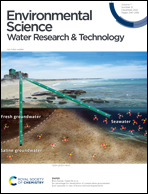Long-term surveillance of wastewater SARS-CoV-2 in Los Angeles County†
Abstract
Wastewater-based epidemiology (WBE) is an effective and versatile tool for monitoring communal viral load. In addition, WBE can enhance clinical surveillance by identifying potential under testing communities. Here we report the results of WBE surveillance of Los Angeles County, CA, one of the largest and most populated metropolises in the United States. We collected weekly samples of 24 hour flow-weighted composite influent from five wastewater treatment plants for 44 weeks. Wastewater SARS-CoV-2 levels were quantified using RT-qPCR targeting the CDC recommended nucleocapsid genes N1 and N2. During our study, wastewater SARS-CoV-2 levels in Los Angeles County experienced two large spikes, once during July–August 2020 and a second during December 2020–January 2021. Wastewater SARS-CoV-2 levels peaked at 3.85E + 05 N1 gene copies per L and 3.79E + 05 N2 gene copies per L during the first spike and 2.55E + 06 N1 gene copies per L and 2.15E + 06 N2 gene copies per L during the second spike. Pearson correlation analysis of wastewater SARS-CoV-2 levels with clinical data showed strong correlations of r = 0.94, p ≪ 0.01 for N1 and N2. Further, wastewater SARS-CoV-2 levels from samples collected once a day, over the course of a week, led clinical data by up to 5 days, which suggests WBE could be used as an early warning system for rising community infections. Monte Carlo simulations, using our measured wastewater SARS-CoV-2 dataset, estimated that the number of infected individuals peaked on January 19th, 2021 with about 1.25 million active cases. The estimated total number of infected individuals for the duration of this study was 3.42 million people, which represents 34.2% of the population residing in Los Angeles County. Interestingly, our estimated number exceeds the cumulative clinical case count by almost 2 million people. This study demonstrates the utility of WBE to track infection dynamics within large communities. Further, WBE data can be used in Monte Carlo simulations to estimate the size of the infected population and complement clinical data-based models to better understand the disease impact on different communities.

- This article is part of the themed collection: Environmental Science – coronavirus research


 Please wait while we load your content...
Please wait while we load your content...